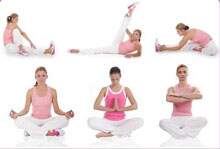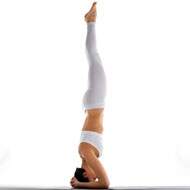Half Headstand Pose - Ardh Sirshasan
The Headstand or Sirsasana is known to be one of the most powerful asanas practiced in yoga. However, this is not an easy asana for most as it requires a fair deal of preparation and abdominal strength in order to have the necessary control to perform the pose.
Apart from exercises for strong abs, poses that release the tightness in your hamstrings and build your upper body strength are also essential before you attempt a full headstand.
The Half Headstand (Ardha Sirsanas) or Dolphin Pose is an ideal preparatory pose as it strengthens the upper body and other areas needed to perform a full headstand.
Steps :
- Begin the pose by sitting in Vajrasana or the Kneeling Pose.
- Once comfortable slowly come up on your toes and raise your heels but keep your knees on the floor.
- Extend your arms straight out in front of you and bend them at your elbows.
- Your forearms should now be resting on the floor in front of your knees.
- Interlock your fingers so that your forearms and elbows form an equilateral triangular shape in front of you.
- Bend down and place the top of your head right in the front of your interlocked fingers.
- Your hands should lightly cup around your head.
- Straighten out and lift your knees and lean your body forward so that your head is resting on the floor.
- Never turn your head when inverted.
- Make sure that there is no pressure on your head but rather that the weight of the body is taken on the arms, back, and shoulders instead.
- Hold this pose for 30 seconds or more.
- Lower the knees to the floor and return to Vajrasana.
- Lie down on your back and relax in the Corpse Pose or Shavasana.
- Once you have mastered the Half-Headstand, you can move on to Sirsasana or Full Headstand.
Beginner’s Tips :
As a beginner, do not hold the half-headstand pose for more than a few minutes. You can place a folded blanket or yoga mat under your elbows and forearms to reduce the pressure on your head. If you cannot manage the pose at all, try doing the asana against a wall. This makes it easier to balance and raise your hips without any fear of falling over.
Precautions :
It is very important that you take some precautions before actually considering the pose. People who suffer from the following ailments should avoid this posture:
- Chronic headaches or migraines
- Neck injury
- Chronic neck pain
- Wrist pain or injury
- Spinal injury
- Glaucoma
- Detached retina
- Conjunctivitis
- Diarrhea
- High blood pressure
- Heart condition
- Brain disease or brain injury
- Ear inflammation
- Near sightedness
- Asthma
- Sinusitis
- Slipped disc
- Vertigo
- Obesity
Besides these there are a number of other factors to be kept in mind before you could begin performing this pose. Firstly, in case you are pregnant or are menstruating you should not perform this pose. Other than this if you have had a recent surgery to your neck or back or you have just had a heavy meal, you should avoid this pose as well. Young children whose bones have not yet fully developed should avoid this pose too so as to avoid any injury to the body. Make sure that you have a trained and certified yoga instructor to help you at every stage when performing the Half Headstand. Performing the pose in the presence of a trained instructor has twofold benefits: it helps to keep away any injuries and also does not compromise on the benefits of the pose.
Benefits to Body Parts :
Practicing the Half Headstand Pose or the Ardha Sirhasana on a regular basis is known to help the body in a number of ways. Some of the benefits that the body will experience are as follows:
- Increases the flow of blood to the brain
- Drains excess blood and lymph collected in the legs
- Improves blood circulation and oxygenation of cells
- Encourages elimination of cellular waste
- Rejuvenates the functioning of the glands and nervous system
- Maintains the health of the uterus and ovaries
- Due to the inversion, extra nourishment is carried to the face, ears, eyes, nose, throat, and lungs
- Strengthens the muscles of the neck, back, and shoulders
- Tones the muscles of the abdomen
- Opens up your rib cage and muscles of the back
- Improves alignment of the spine
Therapeutic Applications :
- Improves memory and functioning of the brain
- Improves concentration
- Helps treat varicose veins
- Reduces swollen ankles and legs
- Relieves symptoms of hemorrhoids
- Reduces problems with the thyroid, parathyroid and pituitary glands
- Increases the blood flow to the scalp and may help reduce hair fall
- Reduces respiratory illnesses
- Improves balance and muscle control
Variations :
- Salamba Shirshasana 2 or Headstand 2
- Eka Pada Shirshasana or Single Leg Headstand
- Baddha Konasana Shirshasana or Bound Angle Pose in Headstand
- Parshvaikapada Shirshasana or Single Leg Headstand
- Baddha Hasta Shirshasana or Bound Hands Headstand
- Parivrttaikapada Shirshasana or Single Leg Revolved Headstand
- Mukta Hasta Shirshasana or Free Hands Headstand
- Salamba Shirshasana 3 or Headstand 3
- Upavishtha Konasana Shirshasana or Seated Angle Pose in Headstand
- Parshva Shirshasana or Side Headstand
- Urdhva Padmasana in Sirsasana or Upward Lotus in Headstand
Preparatory Poses :
To perform a good half-headstand and full headstand you need strong core muscles. Following are some yoga poses that build up your core strength:
- Locust or Salabhasana
- Boat or Navasana
- Plank Pose along with Side Plank and One Legged Plank Pose
- Downward Dog Pose
- Cat Pose
- Janu Sirsasana and Paschimottanasana
Follow Up Poses :
As you complete performing the half headstand, you could end your routine with some follow up poses that will help your body come cool down from the intense routine. Some of the follow up poses include:
- Inversion Poses
- Sirsasana or Full Headstand
 Find Pose
Find Pose

